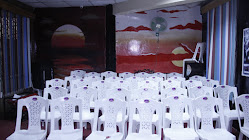Why famous global filmmakers prefer South Africa to Kenya
Nation
Prime
By
JAMES KAHONGEH
Monday December 23 2019
When the movie, Out of Africa, was
shot on Ngong Hills and Constant Gardner in Loiyangalani and Kibera, everyone
thought Kenya would become a destination of Hollywood stars.
Everything was perfect: the weather,
the terrain, the talent. But goodwill and lack of policy to guide the industry
were missing.
Many thought Kenya would become a
film powerhouse.
Crews from Hollywood would camp here
for weeks and months, shooting jaw-dropping films.
Hollywood mega projects such as
Constant Gardner, Netflix’s science fiction series Sense8, Out of Africa and
The Rise and Fall of Idi Amin, were filmed in Kenya.
Hunter boyfriend
Out of Africa, a romantic thriller
directed by Sydney Pollack, was a filmmaker’s dream project.
This movie tells the story of
romance between Danish settler Karen Blixen and her hunter boyfriend Denys
Finch Hatton, who is buried in Ngong Hills.
It was 1985, and when Pollack yelled
“Cut!” to his crew during the making of the movie, Kenya appeared to have
entered the global filmmaking map with a bang.
Writing on IMDb (Internet Movie
Database) in 2006, a critic recalled: “As it ended, the audience sat motionless
and quiet for several beats, then burst into applause as the credits rolled…
We’d just seen the Academy Award winner.”
The movie would live up to its
billing to win seven Academy Awards, including Best Picture and Best Director
for Pollack.
According to a 2015 travel article
in The Telegraph, the safaris and the country’s epic scenery filmed in Out of
Africa “captured the imagination of cinema audiences all over the world and
sold Kenya as a destination in a way that no holiday brochure ever could”.
With its breathtaking sceneries of
sandy beaches, savannah grasslands and plush farmlands, few African countries
would beat Kenya as a filmmakers’ go-to place.
Add to the mix is the tropical
weather throughout the year, the Great Rift Valley slicing the country in half,
dramatic mountain ranges, wildlife, ancient coastal towns and dreamlike inland
water masses.
A filmmaker would not ask for a more
idyllic setting.
Yet with blockbusters interspersed
with smaller unremarkable projects, Kenya’s film star has flickered in and out
over the years.
The country’s acting talent pool is,
by many calibrations, unrivalled in the region.
Kenya’s top cream actors and
actresses, however, seem to be flourishing elsewhere.
Edi Gathegi, with Blacklist, Nikita
and Beauty and the Beast to his name and Oscar award-winning actress Lupita
Nyong’o have had their breakthrough outside the country.
So why has Kenya failed to cash in
on its vast natural and human capital?
The 2019 Kalasha Awards winners
dance and cheer on stage during the ceremony at Safari Park grounds on December
1. Kenya Film Corporation CEO Timothy Owase says it is not fair to compare
Kenya and South Africa. PHOTO | NMG
For a month, the Nation has
engaged stakeholders to understand why the industry keeps blowing hot and cold,
the hurdles it faces and if there is any hope.
This is the heart-rending story of
the industry.
From punitive fees imposed on
filmmakers to inefficiencies and a litany of other compliance bureaucracies,
filming in Kenya is not for the faint-hearted.
The rough environment has inhibited
growth of the local industry and seen international filmmakers shun the country
for others, notably South Africa.
Kenya Film Commission Chief
Executive Timothy Owase, however, thinks it’s not fair to compare the situation
in the two countries.
KFC is the government agency
mandated to promote film in Kenya.
Mr Owase says Kenya lacks the
infrastructural capacity to accommodate mega filming projects.
According to him, South Africa
offers more incentives to filmmakers than Kenya.
“I don’t see this as a problem. It
is an opportunity to develop our infrastructure,” Mr Owase said, criticising
the media “for hyping the matter to look like a crisis”.
“International producers choose to
film on location in a country if it matches their story. If the story is
destined for South Africa, filming in Kenya wouldn’t make sense.”
He argues that filmmakers do not
need a policy to work.
“Assuming that we don’t have a
functioning policy is a fallacy. How have we been able to come up with the
productions in our media?” he asked.
Mr Owase says that with a budget and
proper business plan, filmmakers “should be able to navigate the marshland of
bureaucracies”.
Award-winning film producer Betty
Kathungu-Furet disagrees.
Outdated guidelines
According to Ms Furet, an attempt to
make Kenya a preferred film destination in the absence of the long overdue
policy is futile.
‘‘This policy was developed more
than 15 years ago and has never seen the light of day, resulting in confusion,”
she said. “We’re operating on outdated guidelines developed in the 1950s. How
can we be competitive when other countries have progressive policies?”
Mr Eugene Mbugua, an award-winning
producer, agrees.
“The government does not offer
competitive incentives to filmmakers unlike elsewhere,” he said.
The two said incentives contained in
the proposed policy would motivate local filmmakers and attract external
investors.
“Film is big business. It employs a
full spectrum of businesses, from cast and crew, hotel industry, administrators,
fashion and design, construction and transport,” Ms Furet said.
She, adds, however, that even after
policy adoption, Brand Kenya and the Kenya Tourism Board (KTB) have their work
cut out to market our film aggressively.
The problems do not end with lack of
policy. Filmmakers say the many fees are a hurdle.
“The environment in Kenya is legally
restrictive. Licence fees, especially to beginners with minimal budgets, are
punitive,” Mr Mbugua says.
But even for international behemoths
with nearly inexhaustible outlays, building a mini-Kenya in another country for
a scene is cheaper than filming here.
Such was the case with Inception, a
2010 epic film starring Leonardo Dicaprio. It was originally meant to feature a
scene in Mombasa.
The production crew ruled out the
coastal town, arguing that it was cheaper and less legally restricting to
depict Mombasa away in Morocco, more than 8,800 kilometres away.
As a result, Kenya lost a share of
the $160 million (Sh16 billion) budget for the movie.
Subscribe to:
Post Comments
(
Atom
)


















No comments :
Post a Comment